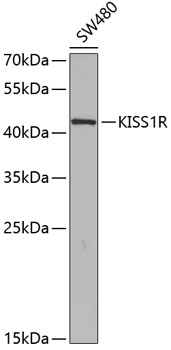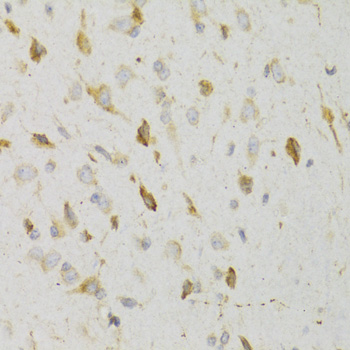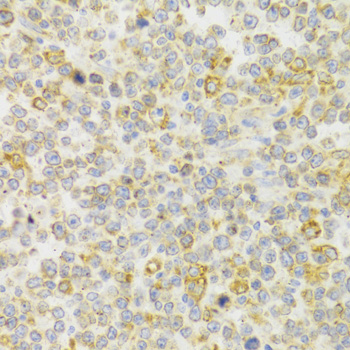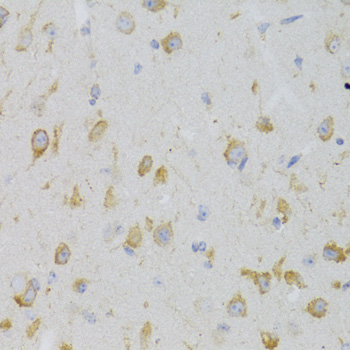-
Product Name
KISS1R Polyclonal Antibody
- Documents
-
Description
Polyclonal antibody to KISS1R
-
Tested applications
WB, IHC
-
Species reactivity
Human, Mouse, Rat
-
Alternative names
KISS1R antibody; AXOR12 antibody; CPPB1 antibody; GPR54 antibody; HH8 antibody; HOT7T175 antibody; KISS-1R antibody; KISS1 receptor antibody
-
Isotype
Rabbit IgG
-
Preparation
Antigen: A synthetic peptide of human KISS1R
-
Clonality
Polyclonal
-
Formulation
PBS with 0.02% sodium azide, 50% glycerol, pH7.3.
-
Storage instructions
Store at -20℃. Avoid freeze / thaw cycles.
-
Applications
WB 1:500 - 1:1000
IHC 1:50 - 1:100 -
Validations

Western blot - KISS1R Polyclonal Antibody
Western blot analysis of extracts of SW480 cells, using KISS1R antibody at 1:350 dilution.Secondary antibody: HRP Goat Anti-Rabbit IgG (H+L) at 1:10000 dilution.Lysates/proteins: 25ug per lane.Blocking buffer: 3% nonfat dry milk in TBST.Detection: ECL Basic Kit .Exposure time: 90s.

Immunohistochemistry - KISS1R Polyclonal Antibody
Immunohistochemistry of paraffin-embedded human gastric cancer using KISS1R Antibody at dilution of 1:200 (40x lens).

Immunohistochemistry - KISS1R Polyclonal Antibody
Immunohistochemistry of paraffin-embedded rat brain using KISS1R Antibody at dilution of 1:100 (40x lens).

Immunohistochemistry - KISS1R Polyclonal Antibody
Immunohistochemistry of paraffin-embedded human B cell lymphoma using KISS1R Antibody at dilution of 1:100 (40x lens).
-
Background
Receptor for metastin (kisspeptin-54 or kp-54), a C-terminally amidated peptide of KiSS1. KiSS1 is a metastasis suppressor protein that suppresses metastases in malignant melanomas and in some breast carcinomas without affecting tumorigenicity. The metastasis suppressor properties may be mediated in part by cell cycle arrest and induction of apoptosis in malignant cells. The receptor is essential for normal gonadotropin-released hormone physiology and for puberty. The hypothalamic KiSS1/KISS1R system is a pivotal factor in central regulation of the gonadotropic axis at puberty and in adulthood. The receptor is also probably involved in the regulation and fine-tuning of trophoblast invasion generated by the trophoblast itself. Analysis of the transduction pathways activated by the receptor identifies coupling to phospholipase C and intracellular calcium release through pertussis toxin-insensitive G(q) proteins.
Related Products / Services
Please note: All products are "FOR RESEARCH USE ONLY AND ARE NOT INTENDED FOR DIAGNOSTIC OR THERAPEUTIC USE"
